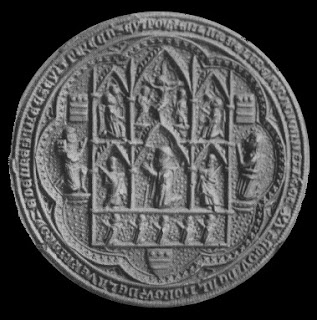This seal is from the 14th century, and so we're now firmly in the heraldic age, as it demonstrates rather nicely.
Haltemprice was a late foundation. In late 1320, Thomas Wake, lord of Liddell, received permission from the pope to found an Austin priory in Cottingham. Failing to find a suitably long-term site, Thomas got the king’s permission in 1322 and the pope’s in 1325 to move his monastery (which by now had some canons from Bourne) to Newton (which was also known as Haltemprice), a couple of miles down the road. The priory was dedicated to the Holy Cross, the BVM and SS. Peter and Paul, and its first prior, Thomas de Overton, was elected in 1327. Wake bequeathed various lands and properties; in 1361 John de Meaux granted the manor of Willerby for a yearly mixed rent of money and requiems. The priory was always small: in 1328, it seems to have had four brethren, including the prior; in 1424 it had 11; at its dissolution in 1536, it had nine. By then, there were also forty servants and boys – we must remember that a monastery wasn’t just its monks, nuns or canons.
Haltemprice was not rich, and any financial mismanagement had grave consequences. In 1367, Archbishop Thoresby of York intervened to get the priory out of its massive debts. In 1400, the pope granted it an indulgence for almsgivers, and an indult for the prior to hear confessions (and, delightfully, in 1402, an indult for the prior and canons to wear shoes rather than their Austin sandals). Disaster struck Haltemprice sometime around then – the bell-tower collapsed during a storm, taking with it much of the church and cloister, and fire destroyed the priory gate and surrounding buildings. To help monastic finances, the pope regranted the indulgence for ten years.
As a local shrine, it boasted an arm of St. George, a piece of the Holy Cross, and a piece of the BVM’s girdle (for women in childbirth). People also prayed to Thomas Wake for fever.
It's now a derelict farmhouse.
On the obverse, (fn. 68) inclosed
in an octofoil, having fleurs de lis and leopards'
heads alternately in the spandrels, is a representation of the house, with two banners on, its roof of
the arms of Thomas, Lord Wake of Liddell, the
founder. On the right is a shield of his arms,
two bars with three roundels in the chief, and
on the left is a burelly shield which perhaps
represents the arms of the Stutevilles of Liddell,
whose heiress was great-grandmother of the
founder. Below is a third shield charged with a
cross paty. The design is contained within an octofoil which has, alternately, fleurs-de-lys and leopards' head in the spandrels.
The legend is ✠ CEO EST LE SEAL LABBE E LE COVENT DE
COTINGHAM QVE NOVS THOMAS WAKE SINGNOVB
DE LIDEL AVOMES FOVNDE.
The counterseal has another octofoil, with trefoils in the spandrels. Two more Wake banners flutter, this time from a big screen, which has the Holy Cross in the top middle (with Christ, Mary and John), and either side two canon thurifers praying. Below is the prior, kneeling in prayer, between St. Peter and
St. Paul, and below them are five praying
canons. Outside this screen are the two founders - dexter, Thomas,
Lord Wake (with armorial ailettes);
sinister, his wife. The Wake arms are in base. The legend continues that of the obverse:
✠ EN L'AN DE L'INCARNACION MILL' CCCXXX SECOVNDE AL HONOVR DE LA VERAI CROYZ E DE N[otr]E DAME E SEYNT PERE E D' SE[yn]T POVL.

